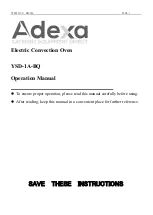
22
oven as a moisture insulator. Wax coated paper plates and cups should be avoided since the high
temperatures that the foods reach may cause the wax to melt. Plastic coated dishes, however, are fi ne
for use in the microwave oven.
Wax paper and paper towels provide an excellent loose cover for foods and help prevent spatters.
Do not use paper towels, plates or other utensils made from recycled paper. Recycled paper products
may contain certain impurities which could cause the paper to ignite during microwave heating. Some
paper products may contain harmful substances.
PLASTIC AND FOAM UTENSILS
Plastic and foam dishes and containers should not be used for cooking foods with high fat or high
sugar content since the heat of the food is too hot for the plastic and may cause it to melt or lose its
shape. Cooking pouches designed to withstand boiling and freezing for conventional cooking, work
well in the microwave oven. Do not close plastic cooking pouches with the metal tie wraps provided,
since they get very hot and will melt the plastic wrap. Any closed pouch or cooking container should be
pierced so that steam is allowed to escape. Do not attempt to cook in plastic storage bags as they will
not withstand the heat of the food. Plastic wrap may be used to cover foods during cooking.Stretch-
type plastic wraps are not suitable for use in the microwave oven because they form too tight a seal.
Whenever removing plastic wrap that has been tightly formed around the utensil, just lift the plastic
away from you so that the steam can vent and there will be no danger of scalding.Melamine is not
recommended for use in the microwave oven.
WICKER, WOOD AND STRAW
Wicker, wood and straw may be used in the oven for short periods of time; however, they should not be
used for high fat or high sugar content foods since the heat of the food could possibly char the utensil.
Wooden handle scrapers and spatulas may be left in the microwave oven during cooking.
Several factors should be kept in mind when selecting utensils to be used for microwave heating.
1. A plate with a narrow rim of about 1/2-inch is recommended. This keeps the food all at the same
level for more even, uniform heating.
2. Casseroles and sauced items should be heated in straight sided containers.
3. Containers should be chosen to be large enough to contain foods as they expand with heating.
Milk products are especially subject to boil-overs.
4. Most foods heat better if they are covered. Covering retains the heat that has been created,
reduces dehydration and helps keep the oven clean. There should be an opening for steam to
escape from the food. Covers should also be non-metallic to allow for proper heating.
Techniques
1. Microwave cooking is ideal for times when you run out of certain items or for preparation during
slow periods.
2. Avoid overcooking. Small portions of food should stand 2-3 minutes following cooking; during
this standing time foods will complete cooking. Large portions require longer standing times.
3. When a range of times is given in a recipe (2-3 minutes), always cook the shorter amount of time
and check for doneness. Foods can always be returned to the microwave for additional cooking.
Overcooked foods are tough or dry.
4. Arrange foods with thicker portions or larger pieces toward the outside of the cooking container.
Most foods cook more evenly and faster if covered.
5. The microwave oven is quite useful in reducing broiling times for steaks and chops. Partially
prepare the meat in microwave oven, then broil for a shorter period of time.
6. Sliced meats should be at least 1/2-inch thick for best heating results. Turning the meat product
overonce during the heating process will yield more uniform heating.
7. Stir liquids briskly before heating and allow to stand at least for 20 seconds after heating before
stirring or drinking to avoid eruption.
Pastries
1. Placing rolls or muffi ns on a paper towel or napkin or wrapping in a paper towel eliminates
excess moisture and gives best results.
2. Avoid overheating. Baked items will be hotter on the inside than on the outside. Overheating
causes baked products to be dry and tough.
Guidelines for microwave heating







































